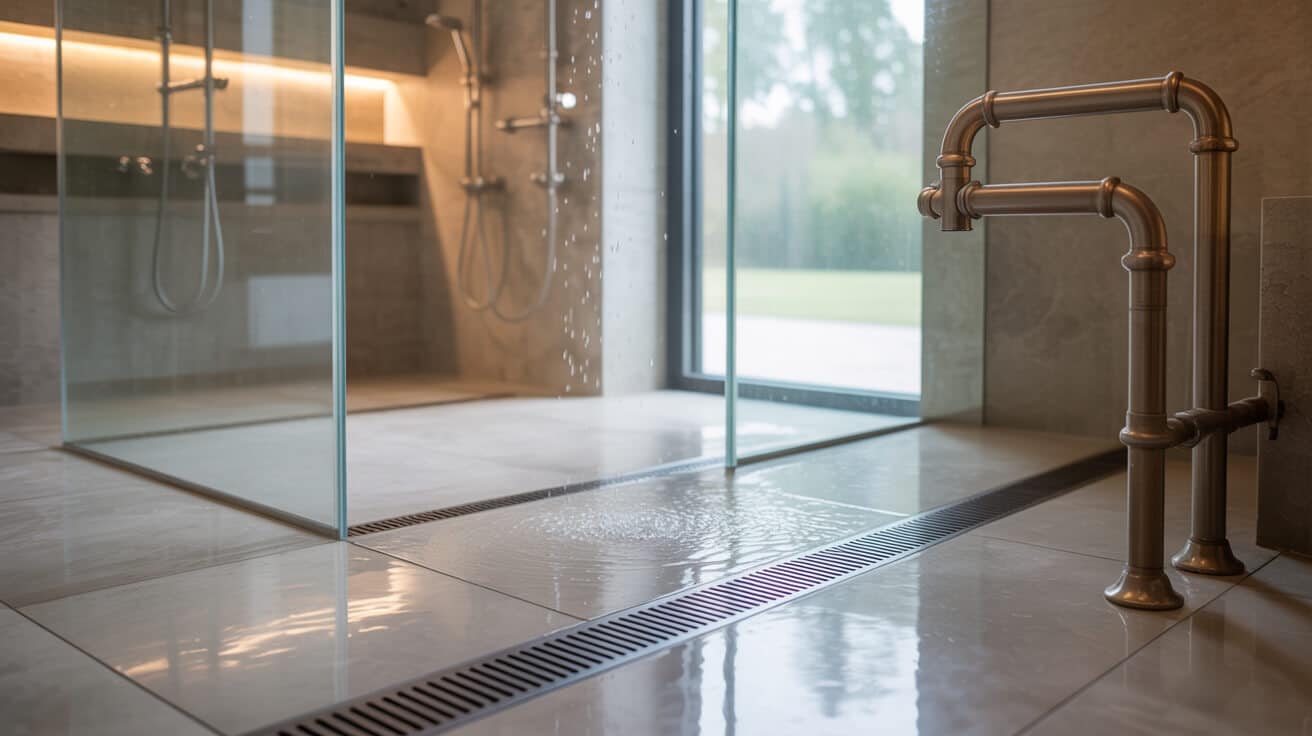A rainwater management system transforms incident rainfall from a source of risk or wastage into a controlled asset supporting property longevity, operational efficiency, and regulatory conformity. Services offered by experienced plumbing and heating companies, such as Plumbers 4U, connect your organisation’s objectives for risk mitigation, value preservation, and environmental responsibility through systemized capture, storage, and redistribution of rainwater. Effective system design demands assessment of catchment area, water usage goals, site geology, regulatory context, and future climate uncertainty, ensuring that solutions respond to both current and anticipated needs across diverse property types.
Rainwater management increasingly forms a node of integration with wider building infrastructure: water-saving features interface with sanitation, heating, and landscape assets to boost utilisation rates and reduce dependence on potable supply. For homeowners, facility managers, and property developers, decisions about system implementation reverberate through operational cost matrices, insurance premiums, and long-term asset value.
Etymology or name origin
The lexicon of rainwater management derives from the convergence of natural process and human agency: “rainwater” denotes direct atmospheric precipitation, while “management” signifies planned intervention and stewardship. Terms rooted in early engineering—such as “soakaway” (an underground structure permitting percolation) or “attenuation” (deliberate reduction of flow rate or volume)—have evolved within technical vocabularies addressing urban hydrology and environmental works. “harvesting,” transferred from agricultural use, now denotes structured rainfall capture for reuse in building services.
Overview and context
Rainwater, unmediated, poses both a resource and a liability for property stakeholders. On impermeable surfaces and complex rooflines, its unmanaged flow can trigger soil erosion, local flooding, structural damage, and downstream overburdening of collective drainage infrastructure. Conversely, judicious intervention allows this ephemeral input to offset potable consumption and reduce the operational footprints of buildings and landscapes.
Environmental imperatives
Increased urban density and climate instability have narrowed the buffer between typical weather and catastrophic event, making effective rainwater management relevant for resilience against incidents such as flash floods, storm surges, and dry-season droughts. Systematic interception and staged release, or on-site reapplication, lessen both the hydraulic load on public sewers and the energetic intensity of water treatment.
Urban development and drainage
Widespread hardscaping and compacted ground typify post-industrial land use, impeding infiltration and amplifying runoff. Modern construction guidelines embed rainwater management at the planning level, often dictating minimum attenuation volumes, permissible discharge rates, and required sustainable features for new and refurbished developments. Integrating system pathways with site drainage achieves regulatory harmony while safeguarding physical plant and landscaped assets.
Water supply infrastructure integration
Rainwater management systems create alternative water cycles for non-potable end uses within the building envelope—supporting irrigation, process supply, or sanitation without commingling with the drinking network. Strategic segregation undergirds public health while expanding your toolkit for occupant or site manager adaptation in response to utility constraints or pricing volatility.
History
Origins in water diversion
Civilizations from antiquity onward harnessed gravity and thresholds to channel rainfall for irrigation or storage. Archaeological evidence documents the use of clay-lined catchments, hand-excavated soakaways, and communal cisterns across Africa, Asia, and the Mediterranean. These relied primarily on passive flow and basic filtration, constrained by thresholds in local geology and rainfall frequency.
Growth with urbanisation and public health
Nineteenth-century industrialization, slope-based city planning, and mass housing all multiplied the magnitude of surface runoff. New risks emerged—ranging from inundated streets and cellars to outbreaks of water-borne disease. Municipal investment directed rainwater away from waste sewers and toward open or piped stormwater collection. Pipelines, underground culverts, and elevation-based engineering introduced both efficiency and systemic vulnerability, as cities struggled with “first flush” pollution events and downstream flooding.
Regulatory and sustainability drivers
Twentieth- and twenty-first-century environmental regulation reframed rainwater management as both obligation and opportunity. Building codes such as the United Kingdom’s Part H, alongside British Standard BS 8515, formalised system design expectations. Municipalities began to incentivize incorporation of permeable surfaces, basins, and native planting. The integration of performance benchmarking, insurance risk models, and incentives for eco-resilient design has positioned rainwater management among the highest-value upgrades for new and existing property portfolios.

Description
Rainwater management systems are structured as interconnected units serving distinct but mutually reinforcing functions: capturing, transferring, processing, and applying rainwater resources to property operations or safe disposition.
Collection
Rainwater is intercepted at the initial point of contact: pitched or flat roofing, paved surfaces, and designated run-off zones. Components such as gutters, scuppers, and downpipes direct flow away from foundations into conveyance infrastructure sized for extreme rainfall projections as well as routine precipitation.
Conveyance and filtration
Captured water passes through inclined, smooth-bore piping, often equipped with access points for inspection or cleaning. gutter guards, debris screens, and silt traps arrest high-mass contaminants, with finer filtration achieved via mesh philtres or sediment chambers. Flushing mechanisms can assist with the first, most-contaminated volumes of heavy rainfall.
Storage and attenuation
Water is detained either temporarily (attenuation) or with intent for reuse (storage). For attenuation, modular crates or vaults mediate the velocity of storm run-off, preventing immediate discharge to public networks and thus mitigating flash-flood risk. Reuse storage is typically achieved with tanks—surface-mounted for accessible sites, or buried where space or temperature constraints dictate.
Treatment techniques
Filtration gradient is determined by intended downstream application; minimal filtering is acceptable for irrigation, while grey uses (toilets, washing equipment) may require multistage filtration and optional ultraviolet or chemical treatment. Isolation from potable systems is rigorously enforced at this stage, often using air gaps or physical disconnectors.
Distribution and reuse
Stored water is supplied to application points either through passive (gravity) feed or active (pumped) distribution. Controls are installed to prioritise stored rainwater, defaulting to mains backup during supply shortfall. Where system functionality integrates with heating or other mechanical services, additional valves and check devices may be specified to maintain hygiene and hydraulic stability.
Purpose and applications
Rainwater management delivers targeted benefits according to site-specific priorities and regulatory mandates.
Flood prevention
Attenuation and staged release strategies absorb peak storm intensity, reducing overflow risk for your property, neighbouring plots, and downstream infrastructure. Strategic implementation lowers the likelihood and cost of insurance-premium spikes triggered by repeated water ingress.
Irrigation and landscape support
Captured rainwater nurtures exterior planting, green roofs, or productive gardens, lessening dependence on metered potable supply. Properties featuring extensive landscape or compliance with environmental stewardship standards leverage these systems for cost containment and regulatory advantage.
Non-potable indoor uses
Plumbed rainwater can serve appliance and fixture needs, notably toilets, urinals, and industrial washing stations, compressing utility bills and relieving grid-level potable demand. These systems are most effective where site occupancy and use patterns generate predictable, repetitive demand.
Heating system linkage
In specialised designs, rainwater assists heating systems as make-up fluid for closed-loop circuits, or supplies pre-heating stages for process water, expanding the possibilities for integration in both residential and commercial plantrooms.
Types and classifications
Harvesting systems
The basic rainwater harvesting system is defined by its approach to collection and storage.
- Above-ground tanks: Freestanding, modular, suited for smaller catchments, ease of access, and removal.
- Below-ground tanks: Sub-root systems installed beneath paved or planted areas, maximising storage while minimising space impact or exposure to freezing.
Both approaches support scalability via modular linking, back-up overflow routing, and upgrades for advanced filtration or pumping.
Soakaways and attenuation
- Soakaway pits/crates: Sub-surface units constructed from high-void aggregate, synthetic crates, or modular cells, sized per soil absorption capacity.
- Attenuation basins/vaults: Designed to buffer storm surges, allow evaporation, and facilitate controlled egress to municipal systems.
Permeable and green features
- Permeable paving: Paver stone or resin-bound surfacing that allows rainfall to philtre through to base course and subsoil.
- Rain gardens/bioretention: Engineered planting zones accepting direct runoff, filtering particulate, and facilitating groundwater recharge.
- Green roofs: Layered living systems that intercept and slow rainfall, cool buildings, and add aesthetic value.
Hybrid installations
Properties with diverse use profiles or regulatory overlays often blend techniques; for example, combining underground tanks for storage with rain gardens for overflow, or positioning above-ground tanks upstream of landscape attenuation beds.
Design and installation
Rainwater management system design reflects a sequence of analytical and practical decisions, each tailored to environment, property function, and stakeholder objectives.
Site assessment
Engineers or trusted suppliers, such as Plumbers 4U, begin by analysing rainfall data, surface hydrology, soil percolation rates, historical flooding, and existing hydraulic infrastructure. These findings dictate both concept and product selection.
Sizing and configuration
Calculations for tank and pipe volumes factor in peak rainfall, property area, regulatory requirements, and redundancy for future climate variability. Building orientation and landscaped elements can be used to augment storage or promote gradual infiltration. Design models may include digital simulations or reference internationally recognised tables and best practices.
Plumbing integration
Installation ensures that controls, piping, and system outputs connect seamlessly with your property’s internal plumbing, without risk of backflow or cross-contamination. Your system may include automatic top-up through mains water, but only via certified backflow prevention devices as per WRAS standards.
Controls and automation
Pump logic, overflow sensors, and flow restrictors automate prioritisation of stored vs. mains water, alert for maintenance intervals, and maintain optimal function. Sensors and timing systems further enhance reliability.
Installation process
System delivery proceeds through preliminary earthworks or building adaptation, phased placement of storage and distribution components, and system commissioning by certified plumbers or allied trades. Documentation and user instruction are standard parts of handover, ensuring knowledge transfer to you or your FM team.

Tools and technologies
Tanks and storage options
Leading solutions employ corrosion-resistant polyethylene, concrete modules, or fibreglass composites. Sizing matches both permitted discharge and end-use expectations. Tank accessibility supports inspection, cleaning, and component replacement. Some tanks include baffling or partitioning for sediment control.
Filtration and pre-treatment
Multi-stage filtration options include:
- Primary: Gutter mesh, leaf guards, debris baskets.
- Secondary: Vortex philtres, cartridge mesh, sedimentation.
- Advanced: UV or chlorine dosing (for higher-grade uses).
regular maintenance schedules optimise long-term effectiveness and minimise failures.
Pump and distribution systems
System types vary by application:
- Submersible pumps: Effective in buried tanks, controlled by float switches.
- Surface-mounted pumps: Easier maintenance, suited for gravity-assisted or low-head systems.
All setups include anti-siphonage, backflow prevention, and redundancy features where high service levels are contractually required.
Sensors and smart controls
Water level and flow indicators, combined with pressure and temperature sensors, detect anomalies and optimise system operability. Customizable logic allows adaptation across seasonal rainfall variations and property use changes.
Approved installation materials
Pipework and connectors—whether for perimeter routing or deep infrastructure—require WRAS certification, and are selected based on resistance to frost, UV exposure, and soil acidity. Pressure-rated values ensure system longevity and safe isolation during repairs.
Regulation and compliance
Building regulations (e.g., Part H, BS 8515)
National and municipal codes determine the sizing, layout, and permitted discharges of rainwater systems. BS 8515 provides parameters for calculation, installation, and operational oversight.
WRAS and WaterSafe compliance
Material and installer certifications guarantee that system components and workmanship conform to recognised standards. Companies such as Plumbers 4U verify that only appropriately accredited professionals touch potable-segmented installations, managing risk for your asset portfolio.
Planning and building control
For above-average storage volumes, landscape intervention, or features altering site hydrology, approval from planning and building authorities is necessary. Submission may require detailed system schematics and simulation outputs.
Health and water quality requirements
Legislation demands isolation of rainwater from potable systems, regular cleaning of tanks and channels, and mitigation of biological risk, especially for systems used in multifamily or institutional settings. Documentation proves compliance for audits or risk management exercises.
Landlord and commercial obligations
Property managers have enhanced responsibilities for inspection, record-keeping, and prompt attention to user or regulator complaints. Maintenance frequency typically scales with system size and intensity of use.
Performance, maintenance, and data
Performance indicators
Metrics for evaluating system effectiveness include:
- Percentage reduction of peak stormwater discharge
- Annual volume of potable offset
- Mean time between repair incidents (MTBRI)
- compliance audit pass rates
Maintenance checklists
Scheduled actions for optimal system function may include:
- Cleaning primary screens and guttering
- Verifying operation of float valves and pumps
- Inspecting for signs of silt build-up or alveolate collapse
- Assessing overflow, bypass, and back-up controls
Inspection and reporting protocols
Professional maintenance visits may include water sampling, component replacement, tank emptying, and documentation to aid in warranty claims, insurance renewals, or scheduled risk audits.
Problems and challenges
Blockage and overflow
Leaf litter, animal ingress, and sediment accumulated from dust or roof debris impede water movement, threatening overflow at eaves and downspouts. Regular inspection addresses incipient faults before escalation.
System faults and repairs
Pumps exposed to power surges, freezing, or seal fatigue may fail, while tanks can develop structural defects over time. Response timelines affect user satisfaction and may disrupt compliance chains, particularly in multi-tenant or public buildings.
Cross-contamination risks
Failure of backflow prevention devices, misconnected pipes, or improper system upgrades can expose potable supplies to untreated water. Compliance with installation standards and ongoing vigilance are non-negotiable for health and legal standing.
Retrofit and site limitations
Retrofit opportunities may be restricted by building heritage status, spatial constraints, or unmodifiable infrastructure. These sites require creative design or may settle for partial system upgrades.
Stakeholders and entities
Homeowners and residents
For your property, the impact of rainwater management spans peace of mind, landscaping care, and insurance risk reduction. User education fortifies system value by encouraging regular, preventative action.
Landlords and property managers
For your rental properties or multi-tenant holdings, system adoption signals due diligence, reduces liability, and may support marketing efforts directed at eco-oriented tenants or buyers.
Commercial and facilities operators
For your company, efficient rainwater management translates to quantifiable cost reductions, smoother regulatory interactions, and a positive risk profile in the eyes of financial or insurance partners.
Installers and service providers
Plumbing and heating specialists, such as Plumbers 4U, guarantee technical compliance, user documentation, and stable after-instal support. Their expertise reduces your long-term cost of ownership and audit exposure.
Municipalities guide the boundaries of design, approve or modify plans, and monitor the effectiveness of communal water management for collective benefit.
Impact and legacy
Rainwater management has shifted from marginal expenditure to central asset in mitigating climate exposure, managing infrastructure strain, and redefining best practice in property operation. As adoption grows, legacy buildings, brownfields, and newly developed assets alike acquire added resilience, efficiency, and value perception. Systematic success is visible in cities replete with green infrastructure, water-sensitive architecture, and lowered incident rates for flooding and drought-induced loss.
Future directions, cultural relevance, and design discourse
The scientific frontier will likely produce lighter, stronger materials, improved filtration media, and predictive analytics for preventive maintenance. Cultural priorities shift toward universalization of sustainable urban water management, while discourse intensifies on the intersection between technology and traditional landscape. As new forms of architecture and city planning prioritise water-resilience, rainwater management will become ever more entwined with the narrative of responsible urban life, and your organisation’s own standing as contributor to collective environmental stewardship.

